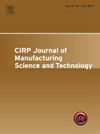The effect of cryogenic treatment on the mechanical properties and cutting performance of coated cemented carbide tools with different Co contents
IF 4.6
2区 工程技术
Q2 ENGINEERING, MANUFACTURING
CIRP Journal of Manufacturing Science and Technology
Pub Date : 2025-02-25
DOI:10.1016/j.cirpj.2025.02.003
引用次数: 0
Abstract
As a supplementary heat treatment process to improve the properties of metals, cryogenic treatment also has a positive effect on cemented carbide. Coated cemented carbide tools with different cobalt contents (WC-6 %Co, WC-8 %Co, and WC-10 %Co) were subjected to cryogenic treatment at −196 °C using liquid nitrogen as the cooling medium, held for 16 and 32 h, respectively, followed by tempering at 200 °C for 2 h. The results showed that cryogenic treatment had the most significant effect on WC-8 %Co. The residual compressive stress increased by 704 %, the coating-substrate adhesion increased by 24 %, and the volume of dry friction and wear decreased by 81.1 %. In the dry high-speed milling of GH202 superalloys, the cutting temperature of the tool was measured using a contact thermocouple method. Tool wear was analyzed using scanning electron microscopy (SEM) and energy-dispersive spectroscopy (EDS), while the thermal conductivity of the tool was evaluated using the laser flash analysis. The results indicated that, compared to tools without cryogenic treatment, the tool life of WC-8 %Co showed the greatest improvement, increasing by approximately 93.1 %. One of the reasons for the enhanced tool life is the increase in the tool's thermal conductivity due to cryogenic treatment, which improved by approximately 3.5 %. Cryogenic treatment leads to the change of internal stress, drives the martensitic transformation of the bonding phase (Co phase), and promotes the transformation from cobalt of face-centered cubic structure (α-Co) to cobalt of hexagonal close-packed structure (ε-Co).
求助全文
约1分钟内获得全文
求助全文
来源期刊

CIRP Journal of Manufacturing Science and Technology
Engineering-Industrial and Manufacturing Engineering
CiteScore
9.10
自引率
6.20%
发文量
166
审稿时长
63 days
期刊介绍:
The CIRP Journal of Manufacturing Science and Technology (CIRP-JMST) publishes fundamental papers on manufacturing processes, production equipment and automation, product design, manufacturing systems and production organisations up to the level of the production networks, including all the related technical, human and economic factors. Preference is given to contributions describing research results whose feasibility has been demonstrated either in a laboratory or in the industrial praxis. Case studies and review papers on specific issues in manufacturing science and technology are equally encouraged.
 求助内容:
求助内容: 应助结果提醒方式:
应助结果提醒方式:


